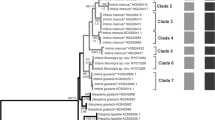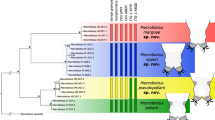Abstract
We found numerous dull brown land planarians of the subfamily Geoplaninae within native rainforests and in nearby man-disturbed habitats in Southeastern and South Brazil. Their external and internal morphology are similar to those of Obama ladislavii (Von Graff, 1899), with the exception of the luminous green dorsum of this species, from which a brownish-green variation is also known. Since morphological features commonly used to delimit geoplaninid species failed to distinguish them, we used coalescent and Bayesian-based molecular methods (GMYC, BPP). These methods indicated that we were actually dealing with three species, the greenish O. ladislavii, and two brownish, cryptic species. A meticulous morphological study of the specimens, including type material of O. ladislavii, allowed us to ascertain diagnostic features for each of the species, for which we also propose a molecular diagnosis. This integrative taxonomic study demonstrates the utility of molecular tools to weigh minor morphological features and thus to reveal otherwise cryptic species.


















Similar content being viewed by others
Abbreviations
- cg:
-
cyanophil glands
- cmc:
-
common muscle coat
- cov:
-
common glandular ovovitelline duct
- de:
-
dorsal epidermis
- di:
-
dorsal insertion
- dm:
-
dorsal cutaneous musculature
- e:
-
eyes
- eg:
-
erythrophil glands
- ej:
-
ejaculatory duct
- es:
-
esophagus
- fa:
-
female atrium
- fgd:
-
female genital duct
- gm:
-
glandular margin
- go:
-
gonopore
- i:
-
intestine
- im:
-
internal pharyngeal musculature
- lu:
-
pharyngeal lumen
- m:
-
mouth
- ma:
-
male atrium
- mc:
-
cutaneous musculature
- mg:
-
glands with mixed secretion
- mm:
-
parenchymal musculature
- n:
-
nerve plate
- o:
-
ovary
- om:
-
outer pharyngeal musculature
- ov:
-
ovovitelline ducts
- p:
-
penis papilla
- pp:
-
pharyngeal pouch
- pv:
-
prostatic vesicle
- rg:
-
rhabditogen glands
- sc:
-
secretory cells
- sd:
-
sperm duct
- sg:
-
shell glands
- sp:
-
sensory pits
- sv:
-
spermiducal vesicle
- t:
-
testes
- v:
-
vitellaria
- ve:
-
ventral epidermis
- vi:
-
ventral insertion
- vm:
-
ventral cutaneous musculature
- xg:
-
xanthophil glands
References
Álvarez-Presas, M., & Riutort, M. (2014). Planarian (Platyhelminthes, Tricladida) diversity and molecular markers: a new view of an old group. Diversity, 6, 323–338.
Álvarez-Presas, M., Baguñà, J., & Riutort, M. (2008). Molecular phylogeny of land and freshwater planarians (Tricladida, Platyhelminthes): from freshwater to land and back. Molecular Phylogenetics and Evolution, 47, 555–568.
Álvarez-Presas, M., Carbayo, F., Rozas, J., & Riutort, M. (2011). Land planarians (Platyhelminthes) as a model organism for fine-scale phylogeographic studies: understanding patterns of biodiversity in the Brazilian Atlantic Forest hotspot. Journal of Evolutionary Biology, 24, 887–896.
Amaral, S. V., Hack I. R., Iturralde G. G. & Leal-Zanchet, A. M. (2014). 1518 Land flatworms (Platyhelminthes: Tricladida) in remnants of decid- 1519 uous forest in the northeast region of southern Brazil. Biota 1520 Neotropica 14(1), 1–6. http://www.biotaneotropica.org.br/v14n1/ 1521 pt/fullpaper?bn00714012014+en
Antunes, M. B., Marques, D. I. L., & Leal-Zanchet, A. M. (2008). Land flatworm (Platyhelminthes, Tricladida, Terricola) community composition in two areas of semi-caducifolius forest in Southern Brazil. Neotropical Biology and Conservation, 3, 34–38. 34.
Antunes, M., Leal-Zanchet, A. M., & Fonseca, C. R. (2012). Habitat structure, soil properties, and food availability do not predict terrestrial flatworms occurrence in Araucaria forest sites. Pedobiologia, 55, 25–31.
Baptista, V. A., Matos, L. B., Fick, I. A., & Leal-Zanchet, A. M. (2006). Community composition of land planarians (Platyhelminthes, Tricladida, Terricola) of the National Park of Aparados da Serra, Brazil. Iheringia. Série Zoologia, 96, 293–297. http://dx.doi.org/10.1590/S0073-47212006000300004
Bickford, D., Lohman, D. J., Sodhi, N. S., Ng, P. K., Meier, R., Winker, K., Ingram, K., & Das, I. (2007). Cryptic species as a window on diversity and conservation. Trends in Ecology & Evolution, 22, 148–155.
Bouckaert, R., Heled, J., Kühnert, D., Vaughan, T., Wu CH, Xie D., Suchard, M., Rambaut, A. & Drummond A. (2014). BEAST2: A software platform for Bayesian evolutionary analysis. PLOS Computational Biology 10(4): doi: e1003537.
Carbayo, F., Leal-Zanchet, A. M., & Vieira, E. M. (2002). Terrestrial flatworm (Platyhelminthes: Tricladida: Terricola) diversity versus man-induced disturbance in an ombrophilous forest in southern Brazil. Biodiversity and Conservation, 11, 1091–1104.
Carbayo, F., Álvarez-Presas, M., Olivares, C. T., Marques, F. P. L., Froehlich, E. M., & Riutort, M. (2013). Molecular phylogeny of Geoplaninae (Platyhelminthes) challenges current classification: proposal of taxonomic actions. Zoologica Scripta, 42, 508–528. doi:10.1111/zsc.12019
Cason, J. E. (1950). A rapid one-step Mallory-Heidenhain stain for connective tissue. Stain Technology, 25(4), 225–226.
Castro, R. A., & Leal-Zanchet, A. M. (2005). Composição de comunidades de planárias terrestres (Platyhelminthes) em áreas de floresta estacional decidual e de campo na região central do Rio Grande do Sul, Brasil. Acta Biologica Leopondensia, 27, 147–150.
Darriba, D., Taboada, G. L., Doallo, R., & Posada, D. (2012). jModelTest 2: more models, new heuristics and parallel computing. Nature Methods, 9, 772. doi:10.1038/nmeth.2109
Drummond, A. J., & Rambaut, A. (2007). BEAST: Bayesian evolutionary analysis by sampling trees. BMC Evolutionary Biology, 7.
Drummond, A. J., Suchard, M. A., Xie, D., & Rambaut, A. (2012). Bayesian phylogenetics with BEAUti and the BEAST 1.7. Molecular Biology and Evolution, 29, 1969–1973.
Ezard, T., Fujisawa, T. & Barraclough, T.G. (2009) SPLITS: SPecies’ LImits by Threshold Statistics. Program and documentation. http://r-forge.r-project.org/projects/splits.
Felsenstein, J. (1985). Confidence limits on phylogenies: an approach using the bootstrap. Evolution, 39, 783–791.
Fick, I. A., Leal-Zanchet, A. M., & Vieira, E. M. (2006). Community structure of land flatworms (Platyhelminthes, Terricola): comparisons between Araucaria and Atlantic forest in Southern Brazil. Invertebrate Biology, 125, 306–313. doi:10.111 1/j.1744-7410.2006.00062.x
Frankham, R., Ballou, J. D., Dudash, M. R., Eldridge, M. D. B., Fenster, C. B., Lacy, R. C., Mendelson, J. R., III, Porton, I. J., Ralls, K., & Ryder, O. A. (2012). Implications of different concepts for conserving biodiversity. Biological Conservation, 153, 25–31.
Froehlich, C. G. (1959). On Geoplanids from Brazil. Boletim da Faculdade de Filosofia, Ciências e Letras da Universidade de São Paulo, Série Zoologia, 22, 201–242.
Hall, T. A. (1999). BioEdit: a user-friendly biological sequence alignment editor and analysis program for Windows 95/98/NT. Nucleic Acids Symposium Series, 41, 95–98.
Hambäck, P., Weingartner, E., Ericson, L., Fors, L., Cassel-Lundhagen, A., Stenberg, J., & Bergsten, J. (2013). Bayesian species delimitation reveals generalist and specialist parasitic wasps on Galerucella beetles (Chrysomelidae): sorting by herbivore or plant host. BMC Evolutionary Biology, 13, 92.
Katoh, K., & Standley, D. M. (2013). MAFFT multiple sequence alignment software version 7: improvements in performance and usability. Molecular Biology and Evolution, 30, 772–780.
Kuhner, M. K. (2006). LAMARC 2.0: maximum likelihood and Bayesian estimation of population parameters. Bioinformatics (Oxford, England), 22, 768–770.
Leaché, A. D., & Fujita, M. K. (2010). Bayesian species delimitation in West African forest geckos (Hemidactylus fasciatus). Proceedings. Biological sciences / The Royal Society, 277, 3071–3077.
Leal-Zanchet, A. M., & Carbayo, F. (2000). Fauna de planárias terrestres (Platyhelminthes, Tricladida, Terricola) da Floresta Nacional de São Francisco de Paula, RS, Brasil: Uma análise preliminar. Acta Biologica Leopoldensia, 22, 19–25.
Leal-Zanchet, A. M., Baptista, V., Campos, L. M., & Raffo, J. F. (2011). Spatial and temporal patterns of land flatworm assemblages in Brazilian Araucaria forests. Invertebrate Biology, 130, 25–33. doi:10.1111/j.1744-7410.2010.00215.x
Lohse, K. (2009). Can mtDNA barcodes be used to delimit species? A response to Pons et al. (2006). Systematic Biology, 58, 439–442.
Ogren, R., & Kawakatsu, M. (1990). Index to the species of the family Geoplanidae (Turbellaria, Tricladida, Terricola). Part I: Geoplaninae. Bull. Fuji Women’s College, 28, 79–166.
Papadopoulou, A., Monaghan, M. T., Barraclough, T. G., & Vogler, A. P. (2009). Sampling error does not invalidate the Yule-Coalescent Model for species delimitation. A response to Lohse (2009). Systematic Biology, 58, 442–444.
Pfenninger, M. & Schwenk, K. (2007). Cryptic animal species are homogeneously distributed among taxa and biogeographical regions. BMC Evolutionary Biology 7, 121. http://www.biomedcentral.com/1471-2148/7/121.
Pons, J., Barraclough, T. G., Gomez-Zurita, J., Cardoso, A., Duran, D. P., Hazell, S., Kamoun, S., Sumlin, W. D., & Vogler, A. P. (2006). Sequence-based species delimitation for the DNA taxonomy of undescribed insects. Systematic Biology, 55, 595–609.
Rambaut, A. & Drummond, A.J. (2007). Tracer v1.4. http://beast.bio.ed.ac.uk/Tracer.
Rannala, B., & Yang, Z. (2003). Bayes estimation of species divergence times and ancestral population sizes using DNA sequences from multiple loci. Genetics, 164, 1645–1656.
Ronquist, F., Teslenko, M., van der Mark, P., Ayres, D. L., Darling, A., Höhna, S., Larget, B., Liu, L., Suchard, M. A., & Huelsenbeck, J. P. (2012). MrBayes 3.2: Efficient Bayesian phylogenetic inference and model choice across a large model space. Systematic Biology, 61, 539–542.
Sluys, R., Solà, E., Gritzalis, K., Vila-Farré, M., Mateos, E., & Riutort, M. (2013). Integrative delineation of species of Mediterranean freshwater planarians (Platyhelminthes: Tricladida: Dugesiidae). Zoological Journal of the Linnean Society, 169, 523–547.
Stamatakis, A. (2006). RAxML-VI-HPC: maximum likelihood-based phylogenetic analyses with thousands of taxa and mixed models. Bioinformatics, 22, 2688–2690.
Talavera, G., & Castresana, J. (2007). Improvement of phylogenies after removing divergent and ambiguously aligned blocks from protein sequence alignments. Systematic Biology, 56, 564–577.
Vieites, D. R., Wollenberg, K. C., Andreone, F., Köhler, J., Glaw, F., & Vences, M. (2009). Vast underestimation of Madagascar’s biodiversity evidenced by an integrative amphibian inventory. Proceedings of the National Academy of Sciences of the United States of America, 106, 8267–8272.
Von Graff, L. (1899). Monographie der Turbellarien II. Tricladida Terricola (Landplanarien). Leipzig: Wilhelm Engelmann. 574 pp., 58 pl.
Yang, Z., & Rannala, B. (2010). Bayesian species delimitation using multilocus sequence data. Proceedings of the National Academy of Sciences, 107, 9264–9269.
Acknowledgements
We thank the Instituto Chico Mendes de Conservação da Biodiversidade, Instituto Brasileiro do Meio Ambiente e dos Recursos Naturais Renováveis (IBAMA), FATMA (Fundação de Amparo e Tecnologia do Meio Ambiente de Santa Catarina), Departamento de Águas e Energia Elétrica do Governo do Estado de São Paulo (DAEE), for licensing the fieldwork. We are grateful to Ana Lúcia Ramos Seitenfus, Délio Endres Júnior, Lisandro Negrete, Luciméri Teixeira, Márcio Hisayuki Sasamori, Piter Kehoma Boll, Vanessa dos Anjos Baptista, Vanderli Dias and Welcy Santos (UNISINOS), Débora Redivo, Marília Jucá, Leonardo Zerbone, Welton Araújo, Claudia Olivares (USP) for their help in sampling flatworms. Tiago Francoy, Júlio Pedroni (USP) and Guilherme Pinto Cauduro (UNISINOS) are thanked for DNA sequencing part of the specimens. Letícia Ayres Guterres and Rafaela Canello (UNISINOS), Ana Cristina Machado Vasconcelos, Amanda Cseh, Yasmin P. Oliveira, Diego Amorim and Adriano Maximiano (EACH, USP) helped with histological processing. Helma Roggenbuck (Zoological Museum Hamburg, MH) is gratefully thanked for kindest support in loan and permission to section the type material of O. ladislavii. Helmut Sattmann and Stefan Szeiler (NHM) are acknowledged for friendly assistance to FC during stay in the museum. FC has financial support from Fundación de Amparo à Pesquisa do Estado de São Paulo (FAPESP Proc, 2014/13661-8). AMLZ had grants from the Brazilian Research Council (CNPq) and the Fundação de Amparo à Pesquisa do Rio Grande do Sul (FAPERGS) in support of this work. Molecular work done at the Universitat de Barcelona (UB, Spain) has been funded by the Ministerio de Ciencia e Innovación, España (CGL2011-23466). SVA has a scholarship from Coordenação de Aperfeiçoamento de Pessoal de Nível Superior (CAPES). MAP is grateful to the Sociedad Española de Genética (SEG) for the financial support to travel to Brazil where examined and made histological sections of some specimens used in this work. Two anonymous referees are acknowledged for their very valuable suggestions on an early version of the manuscript.
Author information
Authors and Affiliations
Corresponding author
Rights and permissions
About this article
Cite this article
Álvarez-Presas, M., Amaral, S.V., Carbayo, F. et al. Focus on the details: morphological evidence supports new cryptic land flatworm (Platyhelminthes) species revealed with molecules. Org Divers Evol 15, 379–403 (2015). https://doi.org/10.1007/s13127-014-0197-z
Received:
Accepted:
Published:
Issue Date:
DOI: https://doi.org/10.1007/s13127-014-0197-z




